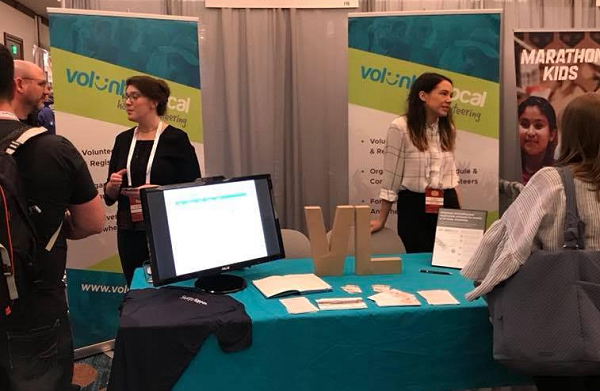 Volunteers come in all stripes. As coordinator, it’s your role to empower them all to help achieve your organization’s goals. Students and community volunteers might have different motivations, schedules, communication styles and levels of experience that impact what they bring to the table. While volunteers from either group should certainly be seen as individuals, here are a few questions to ask:
Volunteers come in all stripes. As coordinator, it’s your role to empower them all to help achieve your organization’s goals. Students and community volunteers might have different motivations, schedules, communication styles and levels of experience that impact what they bring to the table. While volunteers from either group should certainly be seen as individuals, here are a few questions to ask:
Training: Come to you, or go to them?
When you’re working with community volunteers who may be connected as individuals, on-site trainings tend to be best. But if you’re working with a big corporate team, or a large group of students, it can be nice to reserve space on their campus for your volunteers’ convenience. Or, build in a little extra time into the beginning of a shift for “just-in-time” training on your site.
Skilled volunteers, or power in numbers?
Oftentimes, groups of students are used for low-skill, heavy lifting kinds of jobs, and seasoned professionals are recruited to fulfill more skilled roles. Especially with marketing tasks, it can be tough to recruit from a professional pool. Don’t overlook the potential in students, who might be eager to gain experience in everything from graphic design to writing press releases. Same goes for retirees. Some might not be up on the latest social media trend, but they could have project-related skills to contribute. If you have 500 T-shirts to fold, you might want to ask who has experience in retail.
Who gets copied in the email chain?
If you’re working with a group of student volunteers, it could be helpful to copy in a contact from the school – be that an advisor, coach or community engagement professional. Retention of student volunteers is strongest when there’s continuity in the contact, since students move in and out every few years. If you’re late in the game and still recruiting volunteers, ask your best community volunteers to forward your needs to others in their network – perhaps fellow Rotarians or Chamber members.
Here for the service hours, shirt or something more?
Recognition can definitely help with volunteer retention. An excellent student volunteer might benefit from a letter of recommendation for a scholarship. A community volunteer, rather, might be touched by a personal letter sent to their home.
Working with student and community volunteers isn’t very different. It all comes down to building relationships and playing to a volunteer’s strengths.
 Caryline manages 100+ volunteers for the American Cancer Society in communities across Iowa. It took her a long time to learn to trust her volunteers to help her accomplish the organization’s goals – and find some semblance of balance in the process:
Caryline manages 100+ volunteers for the American Cancer Society in communities across Iowa. It took her a long time to learn to trust her volunteers to help her accomplish the organization’s goals – and find some semblance of balance in the process: Joy works with United Way of Central Iowa, an affiliate of the Retired Senior Volunteer Program, and has found communication preferences to be different with her volunteers in the 55+ demographic:
Joy works with United Way of Central Iowa, an affiliate of the Retired Senior Volunteer Program, and has found communication preferences to be different with her volunteers in the 55+ demographic: Chris, who has held roles in community engagement and volunteer management at several large nonprofits and currently works with the Animal Rescue League of Iowa, says his biggest takeaway has been how integrated volunteer goals need to be with the mission and work of the whole professional team:
Chris, who has held roles in community engagement and volunteer management at several large nonprofits and currently works with the Animal Rescue League of Iowa, says his biggest takeaway has been how integrated volunteer goals need to be with the mission and work of the whole professional team:
 You can create custom urls for various jobs.
You can create custom urls for various jobs. You can replicate recurring events using the “copy information from another event” feature.
You can replicate recurring events using the “copy information from another event” feature. You can export data from multiple events to get a big picture of your volunteers.
You can export data from multiple events to get a big picture of your volunteers. Investing in nametags is a great way for volunteer managers to build relationships and stay organized. As Dale Carnegie of
Investing in nametags is a great way for volunteer managers to build relationships and stay organized. As Dale Carnegie of  Volunteer Fairs are a common practice for employers and groups looking to connect their people with causes. But how can you stand out among a veritable smorgasbord of service opportunities? Keep these tools in mind when prepping for success at a volunteer fair.
Volunteer Fairs are a common practice for employers and groups looking to connect their people with causes. But how can you stand out among a veritable smorgasbord of service opportunities? Keep these tools in mind when prepping for success at a volunteer fair.
 Get over your 24/7 do-gooder guilt.
Get over your 24/7 do-gooder guilt.



 Let them know why it matters.
Let them know why it matters. Recruit volunteers who want to develop a specialized skill.
Recruit volunteers who want to develop a specialized skill. Institute a “Mike Rowe” award.
Institute a “Mike Rowe” award. Name the job something creative.
Name the job something creative. Pitch in.
Pitch in..png) Volunteer Captain: Look for someone with a customer service oriented spirit. Inevitably, you will have a few volunteers who arrive to check in awkwardly early, when you’re still in the midst of a few last-minute tasks. Training a friendly and organized volunteer captain or two a few days before the event will free you up from fielding volunteer questions so you can be available to troubleshoot other issues that might arise. Just remember to plan for a frenzy of volunteer activity at every shift change and keep volunteer support especially strong during those periods.
Volunteer Captain: Look for someone with a customer service oriented spirit. Inevitably, you will have a few volunteers who arrive to check in awkwardly early, when you’re still in the midst of a few last-minute tasks. Training a friendly and organized volunteer captain or two a few days before the event will free you up from fielding volunteer questions so you can be available to troubleshoot other issues that might arise. Just remember to plan for a frenzy of volunteer activity at every shift change and keep volunteer support especially strong during those periods. Vendor Greeter: The caterer, the florist, the balloon guy, the sound engineer, the exhibitors – they all seem to arrive in unison and have complex setup questions. If you have a confident friend who knows her way around an event map and can help exhibitors get situated in the right spot, you might not need to clone yourself. If food safety and storage are a concern, it would be wise to secure a capable volunteer familiar with regulations tasked with overseeing that area.
Vendor Greeter: The caterer, the florist, the balloon guy, the sound engineer, the exhibitors – they all seem to arrive in unison and have complex setup questions. If you have a confident friend who knows her way around an event map and can help exhibitors get situated in the right spot, you might not need to clone yourself. If food safety and storage are a concern, it would be wise to secure a capable volunteer familiar with regulations tasked with overseeing that area..png) Social Media Maven:
Social Media Maven:.png) Signage scout:
Signage scout: